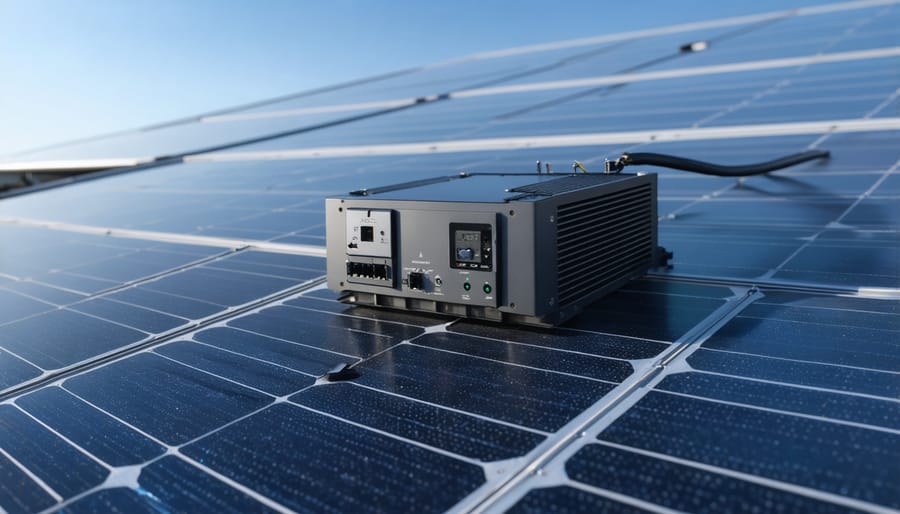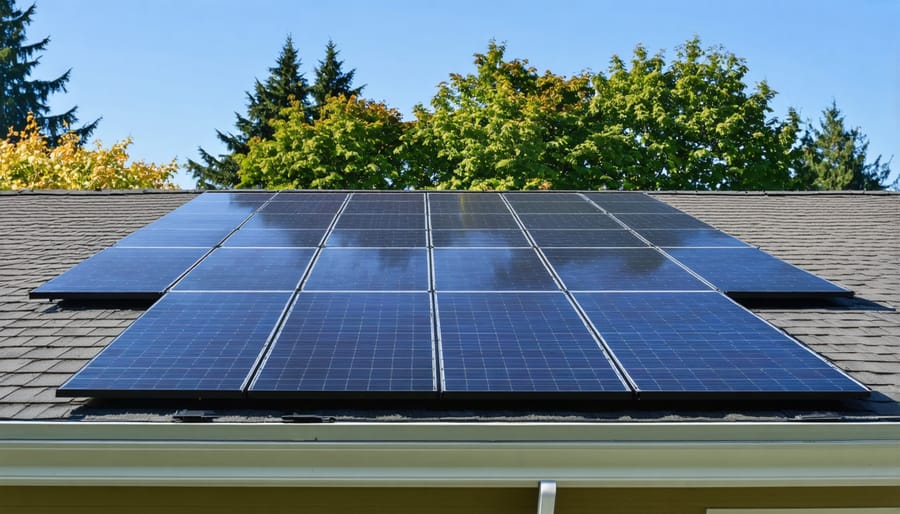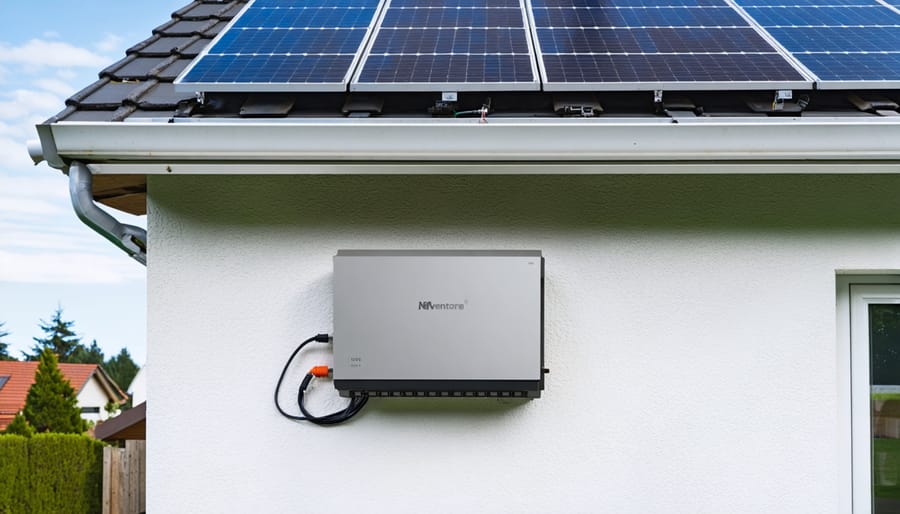The solar panels installed on BC rooftops today bear little resemblance to those from just five years ago—and the most dramatic improvements aren’t in the panels themselves, but in the inverters that convert their energy into usable electricity. Modern inverter technology now delivers 30-40% better energy harvest from the same panels, particularly during BC’s cloudy winter months when older systems struggled. For homeowners and businesses evaluating solar installations, understanding these advancements means the difference between a system that merely offsets some electricity costs and one that delivers genuine energy independence.
**The inverter revolution centers on three breakthrough capabilities.** First, advanced maximum power point tracking (MPPT) extracts optimal power even when clouds pass overhead or morning fog blankets your panels. Second, module-level optimization addresses shading from BC’s abundant trees without compromising your entire array’s output. Third, smart monitoring systems now predict maintenance needs before they impact performance, eliminating the surprise failures that plagued earlier installations.
These aren’t incremental improvements—they represent a fundamental shift in solar economics. A Vancouver Island business recently documented how upgrading just their inverter technology increased annual production by 8,200 kWh without adding a single panel, translating to $1,400 in annual savings at current BC Hydro rates.
What Solar Inverters Actually Do (And Why They Matter)
Think of your solar panels as a garden producing fresh vegetables, and your home as a kitchen that only accepts groceries from a specific store. Solar panels generate DC (direct current) electricity—like those fresh vegetables—but your home runs on AC (alternating current) power, the format supplied by BC Hydro. The solar inverter is the crucial bridge between the two, converting that raw solar energy into power your appliances can actually use.
This conversion process might sound simple, but it’s where the magic happens for your energy bills and investment returns. A high-quality inverter ensures you’re capturing and converting as much solar energy as possible, maximizing every ray of BC sunshine. When inverters operate efficiently, more of your generated power offsets grid electricity, directly reducing your monthly costs.
Modern inverter advancements mean better performance in our region’s unique conditions—those cloudy Vancouver mornings or Kelowna’s hot summer afternoons. Today’s inverters also provide real-time monitoring, letting you track exactly how much energy you’re producing and saving. This transparency helps BC homeowners understand their system’s performance and calculate their return on investment with confidence.
The inverter you choose can represent 15-20% of your total system cost, but it influences 100% of your energy production. A quality inverter typically lasts 10-15 years and can mean the difference between a solar system that merely performs and one that truly delivers on its promise of energy independence and cost savings for your BC home or business.

Five Inverter Advancements Changing Solar in BC
Microinverters: Individual Panel Optimization
Unlike traditional string inverters that connect multiple panels in series, microinverters attach directly to individual solar panels, converting DC power to AC power right at the source. This panel-level optimization means each unit operates independently, preventing one underperforming panel from dragging down your entire system’s output.
For BC homeowners, this technology is particularly valuable. When coastal fog rolls in or clouds pass overhead, microinverters ensure that shaded panels don’t impact the production of sunlit ones. Similarly, if your roof has multiple orientations or angles—common in BC’s diverse architectural landscape—each panel maximizes its potential regardless of how its neighbors are positioned.
Consider the experience of a Vancouver Island family who installed microinverters on their complex roofline with morning shade from nearby cedars. They saw 15-20% higher production compared to estimates for traditional inverters, with consistent performance even during BC’s cloudier months.
Microinverters also simplify system monitoring, letting you track each panel’s performance through user-friendly apps. This transparency helps identify issues quickly and provides peace of mind that your investment is performing optimally year-round.
For BC’s variable weather patterns and unique rooftop configurations, microinverters represent a practical advancement worth considering in your solar journey.

Smart Monitoring and Real-Time Performance Tracking
Modern solar systems now come equipped with sophisticated monitoring technology that puts real-time performance data directly in your hands. Through intuitive smartphone apps, BC homeowners can track their energy production minute-by-minute, compare daily output against weather conditions, and receive instant alerts when panels underperform.
These smart systems detect issues like shading problems, dirty panels, or equipment malfunctions before they significantly impact your energy bill. One Vancouver Island resident discovered a faulty connection within hours of installation, preventing weeks of reduced output that would have otherwise gone unnoticed.
The data empowers you to make informed decisions about your energy consumption. By identifying peak production times, you can shift high-energy activities like running dishwashers or charging electric vehicles to maximize solar usage. Many BC users report reducing grid dependence by 15-20% simply by adjusting their routines based on monitoring insights.
These apps also calculate your environmental impact in real-time, showing carbon offset and tree-planting equivalents—tangible reminders of your contribution to BC’s clean energy future. Combined with battery storage solutions, this monitoring capability helps you maximize savings by storing excess energy during peak production for evening use.

Enhanced Efficiency Ratings (Up to 98%)
Modern inverters have dramatically improved their energy conversion performance, now achieving efficiency ratings between 97-98% compared to older models that typically operated at 93-95%. This means less energy is lost as heat during the conversion from DC to AC power, putting more of your solar harvest to work.
For a typical British Columbia household with a 7 kW solar system generating 8,400 kWh annually, this improvement makes a tangible difference. An older inverter at 93% efficiency would waste approximately 588 kWh per year, while a new 98% efficient model loses only 168 kWh—a savings of 420 kWh. At BC’s average electricity rate of $0.14 per kWh, that’s roughly $60 saved annually, or $1,500 over the inverter’s 25-year lifespan.
For businesses with larger installations, these savings scale significantly. A commercial 50 kW system could save over $400 per year simply through improved inverter efficiency. When combined with BC Hydro’s net metering program, these efficiency gains directly reduce your electricity bills while maximizing your return on investment. If you’re upgrading an existing system or planning a new installation, prioritizing high-efficiency inverters ensures you capture the maximum benefit from every ray of sunshine.
Battery Integration and Energy Storage Compatibility
Modern hybrid inverters have transformed how BC homeowners maximize their solar investments by seamlessly integrating with battery systems. These smart devices store excess electricity generated during sunny midday hours, then automatically release that power during evening peak-rate periods or unexpected outages—ensuring you use every kilowatt-hour your panels produce.
For BC residents enrolled in net metering programs, hybrid inverters offer particular advantages. When your batteries are full and you’re still generating surplus power, the system exports electricity to the grid for credits. During winter months when production dips, you can draw from your stored energy storage before tapping grid power, maximizing your annual savings.
A Kelowna family recently upgraded to a hybrid system and reduced their grid dependency by 85%, even during BC’s cloudier seasons. The key benefit? Complete energy independence during the increasingly common storm-related outages affecting our province. With battery costs dropping 70% since 2015, this integration technology now makes financial sense for most BC households considering solar installations.
Grid-Interactive Features and Rapid Shutdown Safety
Modern solar inverters come equipped with critical safety features that protect both homeowners and utility workers. Rapid shutdown systems, now mandated by BC building codes for new installations, automatically power down solar panels within seconds during emergencies like fires or grid failures. This prevents electrical hazards for first responders and maintenance crews working on your property.
Beyond safety, today’s inverters feature smart grid-interactive capabilities that communicate with BC Hydro’s network in real-time. These systems can automatically adjust power output to help stabilize the grid during peak demand or reduce strain during periods of excess generation. For BC homeowners, this means your solar system actively contributes to community-wide energy resilience while maintaining optimal performance.
The latest inverters also include advanced arc-fault detection, which identifies dangerous electrical arcing before it becomes a fire hazard—particularly important in our coastal climate where moisture can affect connections over time. These features work silently in the background, giving you peace of mind that your investment is protected while supporting a more stable, sustainable energy network for your community.
Real Results: How BC Homeowners Are Benefiting
When the Morrison family in Kelowna upgraded their eight-year-old solar system with a new microinverter setup in 2023, they weren’t sure what to expect. Their original string inverter system had served them well, but inconsistent shading from a neighbor’s growing Douglas fir was increasingly affecting their energy production.
“We were seeing about 15% less production than when we first installed,” explains Sarah Morrison. “Our solar installer recommended switching to microinverters, and honestly, the difference has been remarkable.”
Within the first three months after upgrading, the Morrisons saw their energy production increase by 22% compared to the same period the previous year. Their monthly electricity bills dropped from an average of $85 to just $45, even during BC’s cloudier winter months. The new system’s real-time monitoring also revealed that two panels weren’t performing optimally—an issue their old inverter couldn’t detect.
In Vancouver’s Mount Pleasant neighborhood, the Green Leaf Café took a similar approach. Owner David Chen replaced his aging central inverter with a hybrid model that includes battery storage. “The backup power capability has been a game-changer,” Chen notes. “During last winter’s power outage, we stayed open while neighboring businesses had to close. That alone paid for a significant portion of the upgrade.”
The café now generates 18% more energy than before and has reduced its grid dependence by 65%. Chen reports saving approximately $320 monthly on electricity costs, with the system expected to pay for itself within six years.
These real-world examples demonstrate how BC homeowners and businesses are turning inverter upgrades into tangible financial and environmental benefits.
Choosing the Right Inverter for Your BC Home or Business
Selecting the right inverter for your BC property involves balancing several key factors to maximize your solar investment’s performance and longevity.
**System Size and Energy Needs**
Start by assessing your current electricity consumption and future needs. For smaller residential installations under 10 kW, string inverters often provide excellent value. Growing families or businesses planning to add electric vehicles should consider microinverters or power optimizers that accommodate easy system expansion without replacing core equipment.
**Roof Characteristics Matter**
BC’s diverse architecture means one-size-fits-all solutions rarely work best. Properties with multiple roof planes, dormers, or significant shading from towering Douglas firs benefit tremendously from microinverters or power optimizers, which prevent shaded panels from dragging down entire system performance. Simple, unshaded south-facing roofs work beautifully with string inverters.
**Budget Considerations**
While microinverters carry higher upfront costs, they often deliver better long-term value through enhanced energy harvest and panel-level monitoring. String inverters minimize initial investment but may require full replacement after 10-15 years. Calculate your total cost of ownership over 25 years rather than focusing solely on installation price.
**Climate-Specific Features**
BC’s coastal humidity and temperature variations demand inverters rated for our conditions. Look for models with excellent thermal management and moisture resistance ratings, particularly for installations in wetter regions like the Lower Mainland or Vancouver Island.
**Working with Certified Professionals**
Partner with certified solar installers who understand BC’s unique requirements and can conduct proper site assessments. Experienced professionals will evaluate your specific situation, recommend appropriate technology, and ensure compliance with local regulations and utility interconnection requirements. They’ll also help you navigate available provincial and federal incentive programs to maximize your savings.
What This Means for Your Solar Investment
Modern inverter technology transforms solar from a simple investment into a strategic financial decision with compounding returns. While advanced inverters may add 10-15% to your upfront system costs, they typically deliver 20-30% improvements in energy harvest over the system’s lifetime—significantly boosting your return on investment.
Here’s what these advancements mean for your bottom line: optimized energy production translates to lower electricity bills year after year, while extended equipment warranties (now commonly 25 years for premium inverters) protect your investment long-term. Reduced maintenance requirements mean fewer service calls and lower operational costs, particularly important for BC’s commercial installations.
The smart monitoring capabilities inherent in today’s inverters also future-proof your system. As BC’s energy landscape evolves—with potential changes to net metering policies or new grid integration requirements—modern inverters can adapt through firmware updates rather than requiring costly hardware replacements.
For BC residents, financial incentives help offset initial costs. Federal programs like the Canada Greener Homes Grant, combined with provincial initiatives and utility rebates, can reduce your net investment by 20-40%. Vancouver’s Thompson Community Centre recently showcased this value proposition: their upgraded inverter system paid for itself in under six years through improved efficiency alone.
The key takeaway? Today’s inverter technology isn’t just about producing more power—it’s about maximizing the financial and environmental returns on every solar panel you install, while ensuring your system remains competitive and compatible with future energy innovations.
Inverter technology is evolving at an impressive pace, offering BC residents more efficient, reliable, and cost-effective solar solutions than ever before. From rapid shutdown features that enhance safety to AI-powered optimization that maximizes every ray of Pacific Northwest sunshine, these advancements directly translate to better performance and greater savings for your home or business.
Whether you’re considering your first solar installation or thinking about upgrading an existing system, understanding which inverter technology aligns with your specific needs is essential. The right choice depends on factors like your roof configuration, shading patterns, energy consumption, and budget—considerations that certified professionals can help you navigate.
Ready to explore how these innovations can work for your property? Connect with certified Solar BC installers who understand local conditions and can assess which inverter solution delivers the best results for your situation. Many installers offer free consultations and can use interactive calculation tools to project your potential savings based on BC’s unique climate and incentive programs. Taking this step today means you’ll benefit from the latest technology while contributing to British Columbia’s clean energy future.

